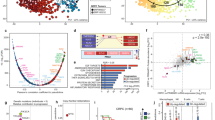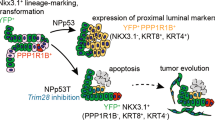Abstract
XMRV was first described in 2006, when it was identified in samples isolated from prostate cancer tissues. However, studies have since shown that XMRV arose in the laboratory and was formed by genetic recombination between two viral genomes carried in the germline DNA of mice used during serial transplantation of the CWR22 prostate cancer xenograft. These new findings strongly imply that XMRV does not circulate in humans, but is only present in the laboratory. Thus, there is no reason to believe that it has any role in the etiology of prostate cancer or other diseases.
This is a preview of subscription content, access via your institution
Access options
Subscribe to this journal
Receive 12 print issues and online access
$209.00 per year
only $17.42 per issue
Buy this article
- Purchase on Springer Link
- Instant access to full article PDF
Prices may be subject to local taxes which are calculated during checkout


Similar content being viewed by others
References
Voisset, C., Weiss, R. A. & Griffiths, D. J. Human RNA “rumor” viruses: the search for novel human retroviruses in chronic disease. Microbiol. Mol. Biol. Rev. 72, 157–196 (2008).
Weiss, R. A cautionary tale of virus and disease. BMC Biol. 8, 124 (2010).
Urisman, A. et al. Identification of a novel Gammaretrovirus in prostate tumors of patients homozygous for R462Q RNASEL variant. PLoS Pathog. 2, e25 (2006).
Carpten, J. et al. Germline mutations in the ribonuclease L gene in families showing linkage with HPC1. Nat. Genet. 30, 181–184 (2002).
Dong, B. et al. An infectious retrovirus susceptible to an IFN antiviral pathway from human prostate tumors. Proc. Natl Acad. Sci. USA 104, 1655–1660 (2007).
Ruscetti, S. K. Deregulation of erythropoiesis by the Friend spleen focus-forming virus. Int. J. Biochem. Cell Biol. 31, 1089–1109 (1999).
Pandhare-Dash, J., Mantri, C. K., Gong, Y., Chen, Z. & Dash, C. XMRV accelerates cellular proliferation, transformational activity, and invasiveness of prostate cancer cells by downregulating p27Kip1. Prostate doi:10.1002/pros.21491.
Schlaberg, R., Choe, D. J., Brown, K. R., Thaker, H. M. & Singh, I. R. XMRV is present in malignant prostatic epithelium and is associated with prostate cancer, especially high-grade tumors Proc. Natl Acad. Sci. USA 106, 16351–16356 (2009).
Arnold, R. S. et al. XMRV infection in patients with prostate cancer: novel serologic assay and correlation with PCR and FISH. Urology 75, 755–761 (2010).
Danielson, B. P., Ayala, G. E. & Kimata, J. T. Detection of xenotropic murine leukemia virus-related virus in normal and tumor tissue of patients from the Southern United States with prostate cancer is dependent on specific polymerase chain reaction conditions. J. Infect. Dis. 202, 1470–1477 (2010).
Onlamoon, N. et al. Infection, viral dissemination, and antibody responses of rhesus macaques exposed to the human gammaretrovirus XMRV. J. Virol. 85, 4547–4557 (2011).
Sfanos, K. S. et al. A molecular analysis of prokaryotic and viral DNA sequences in prostate tissue from patients with prostate cancer indicates the presence of multiple and diverse microorganisms. Prostate 68, 306–320 (2008).
Fischer, N. et al. Prevalence of human gammaretrovirus XMRV in sporadic prostate cancer. J. Clin. Virol. 43, 277–283 (2008).
D'Arcy, F. et al. No evidence of XMRV in Irish prostate cancer patients with the R462Q mutation. Eur. Urol. Suppl. 7, 271 (2008).
Hohn, O. et al. Lack of evidence for xenotropic murine leukemia virus-related virus (XMRV) in German prostate cancer patients. Retrovirology 6, 92 (2009).
Sakuma, T. et al. No evidence of XMRV in prostate cancer cohorts in the Midwestern United States. Retrovirology 8, 23 (2011).
Switzer, W. M., Jia, H., Zheng, H., Tang, S. & Heneine, W. No association of xenotropic murine leukemia virus-related viruses with prostate cancer. PLoS ONE 6, e19065 (2011).
Aloia, A. L. et al. XMRV: a new virus in prostate cancer? Cancer Res. 70, 10028–10033 (2010).
Martinez-Fierro, M. L. et al. Identification of viral infections in the prostate and evaluation of their association with cancer. BMC Cancer 10, 326 (2010).
Verhaegh, G. W. et al. Prevalence of human xenotropic murine leukemia virus-related gammaretrovirus (XMRV) in Dutch prostate cancer patients. Prostate 71, 415–420 (2011).
Furuta, R. et al. No association of xenotropic murine leukemia virus-related virus with prostate cancer or chronic fatigue syndrome in Japan. Retrovirology 8, 20 (2011).
Stieler, K. et al. No detection of XMRV in blood samples and tissue sections from prostate cancer patients in Northern Europe. PLoS ONE 6, e25592 (2011).
Robinson, M. J. et al. No evidence of XMRV or MuLV sequences in prostate cancer, diffuse large B-Cell lymphoma, or the UK blood donor population. Adv. Virol. doi:10.1155/2012/782353.
Waugh, E. M. et al. The retrovirus XMRV is not directly involved in the pathogenesis of common types of lymphoid malignancy. Cancer Epidemiol. Biomarkers Prev. 20, 2232–2236 (2011).
Balada, E., Castro-Marrero, J., Felip, L., Vilardell-Tarres, M. & Ordi-Ros, J. Xenotropic murine leukemia virus-related virus (XMRV) in patients with systemic lupus erythematosus. J. Clin. Immunol. 31, 584–587 (2011).
Lintas, C. et al. Lack of infection with XMRV or other MLV-related viruses in blood, post-mortem brains and paternal gametes of autistic individuals. PLoS ONE 6, e16609 (2011).
Gray, E. R. et al. No evidence of XMRV or related retroviruses in a London HIV-1-positive patient cohort. PLoS ONE 6, e18096 (2011).
Barnes, E. et al. Failure to detect xenotropic murine leukemia virus-related virus in blood of individuals at high risk of blood-borne viral infections. J. Infect. Dis. 202, 1482–1485 (2011).
Tang, S. et al. Absence of detectable xenotropic murine leukemia virus-related virus in plasma or peripheral blood mononuclear cells of human immunodeficiency virus Type 1-infected blood donors or individuals in Africa. Transfusion 51, 463–468 (2011).
Maggi, F. et al. Xenotropic murine leukaemia virus-related virus is not found in peripheral blood cells from treatment-naive human immunodeficiency virus-positive patients. Clin. Microbiol. Infect. doi:10.1111/j.1469-0691.2011.03580.x.
Schmitt, M., Hofler, D., Koleganova, N. & Pawlita, M. Human polyomaviruses and other human viruses in neuroendocrine tumors. Cancer Epidemiol. Biomarkers Prev. 20, 1558–1561 (2011).
Cornelissen, M. et al. Lack of detection of XMRV in seminal plasma from HIV-1 infected men in The Netherlands. PLoS ONE 5, e12040 (2010).
Jeziorski, E. et al. No evidence for XMRV association in pediatric idiopathic diseases in France. Retrovirology 7, 63 (2010).
Satterfield, B. C., Garcia, R. A., Gurrieri, F. & Schwartz, C. E. PCR and serology find no association between xenotropic murine leukemia virus-related virus (XMRV) and autism. Mol. Autism 1, 14 (2010).
McCormick, A. L., Brown, R. H., Cudkowicz, M. E., Al-Chalabi, A. & Garson, J. A. Quantification of reverse transcriptase in ALS and elimination of a novel retroviral candidate. Neurology 70, 278–283 (2008).
Lombardi, V. C. et al. Detection of an infectious retrovirus, XMRV, in blood cells of patients with chronic fatigue syndrome. Science 326, 585–589 (2009).
Erlwein, O. et al. Failure to detect the novel retrovirus XMRV in chronic fatigue syndrome. PLoS ONE 5, e8519 (2011).
Groom, H. et al. Absence of xenotropic murine leukaemia virus-related virus in UK patients with chronic fatigue syndrome. Retrovirology 7, 10 (2010).
Lo, S.-C. et al. Detection of MLV-related virus gene sequences in blood of patients with chronic fatigue syndrome and healthy blood donors. Proc. Natl Acad. Sci. USA 107, 15874–15879 (2010).
Hue, S. et al. Disease-associated XMRV sequences are consistent with laboratory contamination. Retrovirology 7, 111 (2010).
Oakes, B. et al. Contamination of human DNA samples with mouse DNA can lead to false detection of XMRV-like sequences. Retrovirology 7, 109 (2010).
Robinson, M. J. et al. Mouse DNA contamination in human tissue tested for XMRV. Retrovirology 7, 108 (2010).
Sato, E., Furuta, R. A. & Miyazawa, T. An endogenous murine leukemia viral genome contaminant in a commercial RT-PCR kit is amplified using standard primers for XMRV. Retrovirology 7, 110 (2010).
Tuke, P. W., Tettmar, K. I., Tamuri, A., Stoye, J. P. & Tedder, R. S. PCR master mixes harbour murine DNA sequences. Caveat emptor! PLoS ONE 6, e19953 (2011).
Erlwein, O. et al. DNA extraction columns contaminated with murine sequences. PLoS ONE 6, e23484 (2011).
Simmons, G. et al. Failure to confirm XMRV/MLVs in the blood of patients with chronic fatigue syndrome: A multi-laboratory study. Science 334, 814–817 (2011).
Bubbers, J. E. & Lilly, F. Selective incorporation of H-2 antigenic determinants into Friend virus particles. Nature 266, 458–459 (1977).
Ott, D. E. Cellular proteins detected in HIV-1. Rev. Med. Virol. 18, 159–175 (2008).
Paprotka, T. et al. Recombinant origin of the retrovirus XMRV. Science 333, 97–101 (2011).
Paine, E., Garcia, J., Philpott, T. C., Shaw, G. & Ratner, L. Limited sequence variation in human T-lymphotropic virus type 1 isolates from North American and African patients. Virology 182, 111–123 (1991).
Overbaugh, J. & Bangham, C. R. Selection forces and constraints on retroviral sequence variation. Science 292, 1106–1109 (2001).
Knouf, E. C. et al. Multiple integrated copies and high-level production of the human retrovirus XMRV (xenotropic murine leukemia virus-related virus) from 22Rv1 prostate carcinoma cells. J. Virol. 83, 7353–7356 (2009).
Todaro, G. J., Arnstein, P., Parks, W. P., Lennette, E. H. & Huebner, R. J. A Type-C virus in human rhabdomyosarcoma cells after inoculation into NIH swiss mice treated with antithymocyte serum. Proc. Natl Acad. Sci. USA 70, 859–862 (1973).
Sfanos, K. S. et al. Identification of replication competent murine gammaretroviruses in commonly used prostate cancer cell lines. PLoS ONE 6, e20874 (2011).
Zhuang, J., Mukherjee, S., Ron, Y. & Dougherty, J. P. High rate of genetic recombination in murine leukemia virus: Implications for influencing proviral ploidy. J. Virol. 80, 6706–6711 (2006).
Knox, K. et al. No evidence of murine-like gammaretroviruses in CFS patients previously identified as XMRV-infected. Science 333, 94–97 (2011).
Alberts, B. Editorial expression of concern. Science 333, 35 (2011).
Silverman, R. H. et al. Partial retraction. Science 334, 176 (2011).
Garson, J. A., Kellam, P. & Towers, G. J. Analysis of XMRV integration sites from human prostate cancer tissues suggests PCR contamination rather than genuine human infection. Retrovirology 8, 13 (2011).
Rusmevichientong, A., Das Gupta, J., Elias, P. S., Silverman, R. H. & Chow, S. A. Analysis of single nucleotide polymorphisms in XMRV patient-derived integration sites reveals contamination from cell lines acutely infected by XMRV. J. Virol. 85, 12830–12834 (2011).
Groom, H. C. T., Yap, M. W., Galao, R. P., Neil, S. J. D. & Bishop, K. N. Susceptibility of xenotropic murine leukemia virus-related virus (XMRV) to retroviral restriction factors. Proc. Natl Acad. Sci. USA 107, 5166–5171 (2010).
Stieler, K. & Fischer, N. Apobec 3G efficiently reduces infectivity of the human exogenous gammaretrovirus XMRV. PLoS ONE 5, e11738 (2010).
Paprotka, T. et al. Inhibition of xenotropic murine leukemia virus-related virus by APOBEC3 proteins and antiviral drugs. J. Virol. 84, 5719–5729 (2010).
Cohen, J. More negative data for link between mouse virus and human disease. Science 331, 1253–1254 (2011).
Coffin, J. M., Hughes, S. H. & Varmus, H. E. (eds) Retroviruses (Cold Spring Harbor Laboratory Press, Plainview, 1997).
Rein, A. Murine leukemia viruses: objects and organisms. Adv. Virol. doi:10.1155/2011/403419.
Cingöz, O. & Coffin, J. M. Endogenous murine leukemia viruses: relationship to XMRV and related sequences detected in human DNA samples. Adv. Virol. doi:10.1155/2011/940210.
Acknowledgements
The authors would like to acknowledge Dr Saraswati Sukumar for helpful discussions. Research by A. Aloia and A. Rein is supported by the Intramural Research Program of the NIH, National Cancer Institute, Center for Cancer Research.
Author information
Authors and Affiliations
Contributions
All authors researched data for the article, made substantial contributions to discussions of content, wrote the article and reviewed and edited the manuscript before submission.
Corresponding author
Ethics declarations
Competing interests
The authors declare no competing financial interests.
Rights and permissions
About this article
Cite this article
Sfanos, K., Aloia, A., De Marzo, A. et al. XMRV and prostate cancer—a 'final' perspective. Nat Rev Urol 9, 111–118 (2012). https://doi.org/10.1038/nrurol.2011.225
Published:
Issue Date:
DOI: https://doi.org/10.1038/nrurol.2011.225
This article is cited by
-
What can academia learn from XMRV studies?
Nature Reviews Urology (2012)
-
Learning from a controversy
Nature Reviews Urology (2012)
-
Phylogenetic and biological analysis of a laboratory-generated gammaretrovirus xenotropic murine leukemia virus-related virus (XMRV)
Virus Genes (2012)



